Manchester United’s strategy away at Manchester City on Sunday afternoon was obvious — sit deep and counter.
Erik ten Hag set up in a formation that was effectively 4-2-4-0, with Scott McTominay and Bruno Fernandes as his two most advanced central players and Marcus Rashford and Alejandro Garnacho attacking from wide. There was no attempt to dominate possession, press, or take on Manchester City in an open game. United scored early and then the question was whether City could break down a deep block.
Inevitably, they could, and a key part of their success was the performance of Rodri and John Stones, notionally a holding midfielder and a centre-back but effectively, as usual, a midfield duo in a 3-2-5 shape when City had possession.
Below, you can see City’s general shape, which is fairly well established by now. Bernardo Silva and Kevin De Bruyne pushed forward into the channels to form a front five. Rodri and Stones controlled the centre. Nathan Ake and Kyle Walker were wide centre-backs who could push forward. Off screen, Ruben Dias is the sole permanent centre-back.
But Rodri and Stones didn’t simply stay in those midfield positions — they caused United serious problems with their forward running. Early on, De Bruyne moved towards the left to receive a pass from Bernardo. On the edge of the D, Stones is being marked by McTominay.

However, space opens up in the channel, so Stones suddenly springs forward and makes a run behind United’s defence. McTominay has no idea of that movement behind him and De Bruyne finds Stones with a good reverse pass.
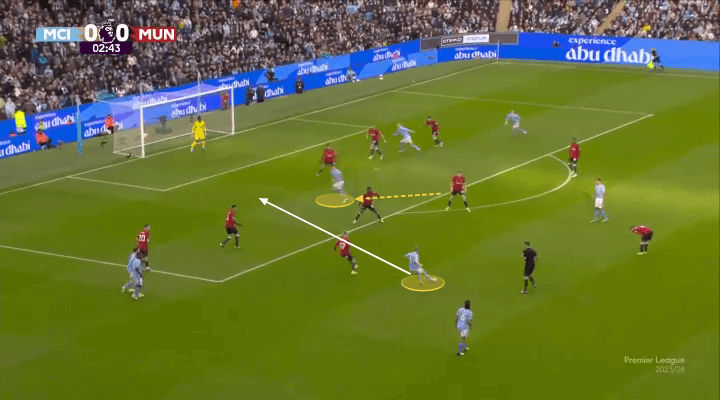
Casemiro has to intervene, just prodding the ball away from Stones before he can shoot.

Those sudden movements, from in front of United’s advanced midfielders to a position beyond them, repeatedly allowed City to get into good positions. Often, the ball came from Walker on the right.
This is a good example because it shows how, despite United playing with four central midfielders, they became stretched and conceded a huge amount of space. Kobbie Mainoo is to the left, watching De Bruyne. Casemiro is on top of his right-back, Diogo Dalot, watching Bernardo. Rodri can therefore waltz through the centre. McTominay points at his run, but it’s too late. In the end, Rodri rushes his final ball and Erling Haaland can’t get on the end of it, but the danger is there.
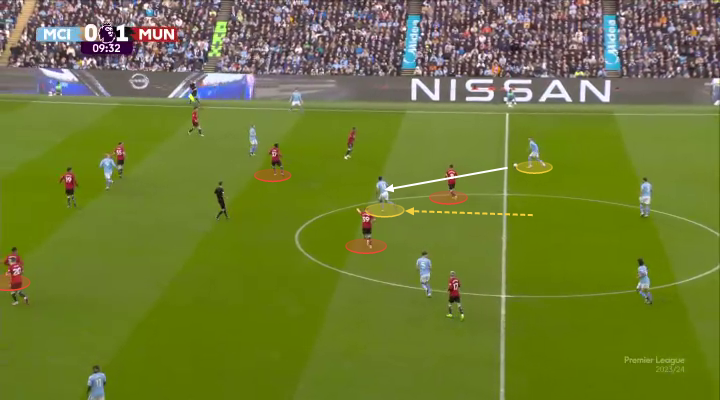
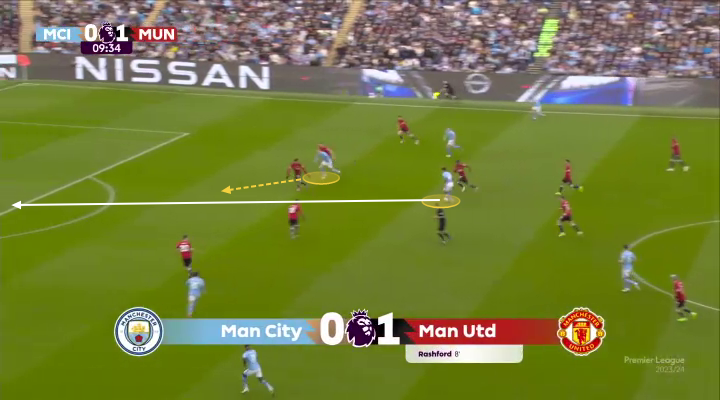
Here’s a similar example, this time with Stones. Again, there are four Manchester United central midfielders trying to stop this type of pass, but a simple forward ball from Walker finds Stones in a dangerous position between the lines. There’s no killer ball on here, so he sweeps out play to the unmarked Jeremy Doku down the left.
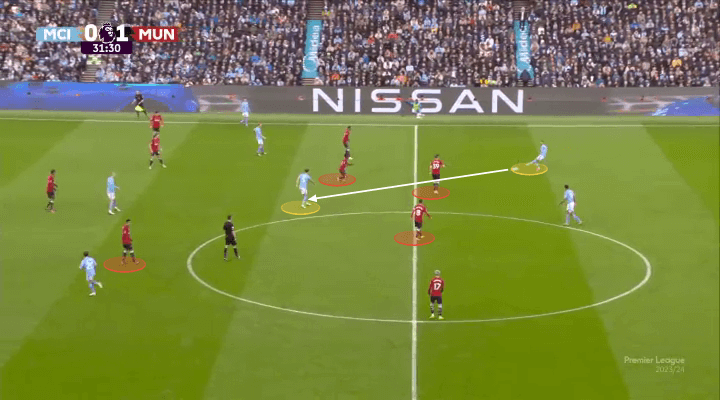

The pattern became more extreme in the second half because Rodri and Stones seemed to position themselves more permanently between the lines.
This time, it’s De Bruyne playing the pass — Stones probably could have taken this ball on the turn, but plays a return ball.
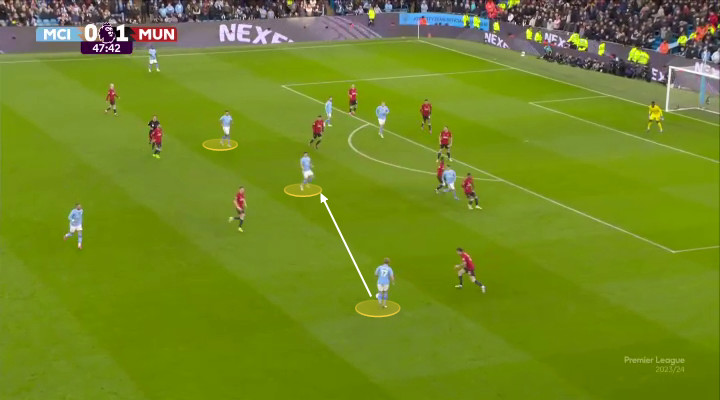

Here’s another ball from Walker — this time fired at an awkward height into Rodri, who miscontrols.

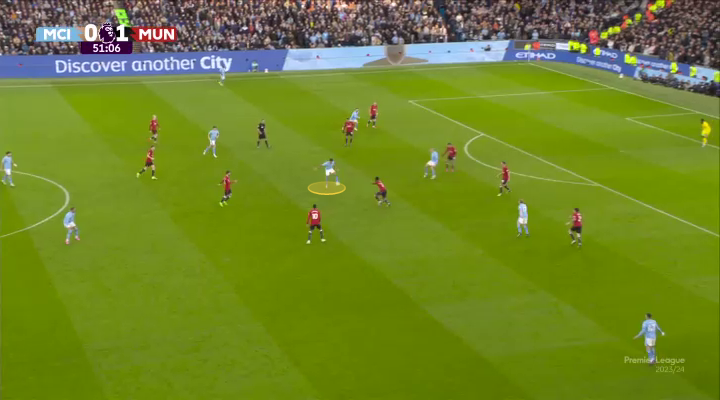
But eventually, the positivity of Rodri and Stones brought goals. Here, Rodri is free to receive the ball from Doku and then sweeps the ball out to Foden on the near side. Rodri gets an assist for this, which could be seen as a bit generous — this is, after all, a simple sideways pass.
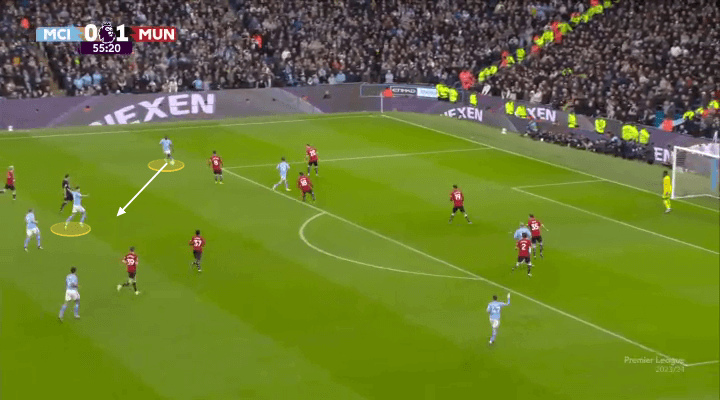

Rodri does, however, genuinely create the goal — and not because of that pass. Rather than holding his position, Rodri makes a run into the channel — the run you usually expect of De Bruyne — and that takes McTominay away.
Look at the position McTominay is in on the edge of the D when Foden touches the ball inside onto his left foot and look at his position where Foden shoots from. If Rodri didn’t make the run, Foden wouldn’t have space to shoot.


The second goal isn’t entirely dissimilar. This time, Foden pops up on the left and, as he goes to play a one-two with substitute Julian Alvarez, Mainoo is ensuring he’s touch-tight to Stones in the centre. Again, it’s worth reiterating that this is a City centre-back who has popped up in a No 10 position and is distracting an opposition holding midfielder.

Without Stones being positioned there, maybe Mainoo senses what Foden is about to do, moves across and covers the space in the channel. Instead, Foden is given space to shoot.


The third goal is a little different but, at 2-1 up in stoppage time, how many other holding midfielders would go haring into the final third to shut down an opposition holding midfielder?
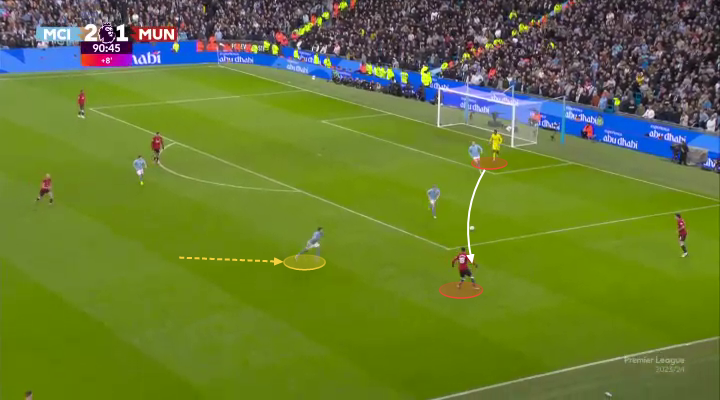
Rodri’s pressing tempts Casemiro into a risky dinked pass to Sofyan Amrabat and then he goes after the Moroccan, too, dispossessing him and playing in Haaland, who scores his trademark low left-footed shot into the bottom corner.


Once, it seemed Guardiola wanted five players to attack and then five to guard against counters — but things have become more flexible.
Stones stepping forward into midfield is not new, nor is Rodri providing a threat in the final third, but increasingly they are taking on even more attacking responsibility. Against United, that proved to be crucial in all three goals.
Read the full article here


